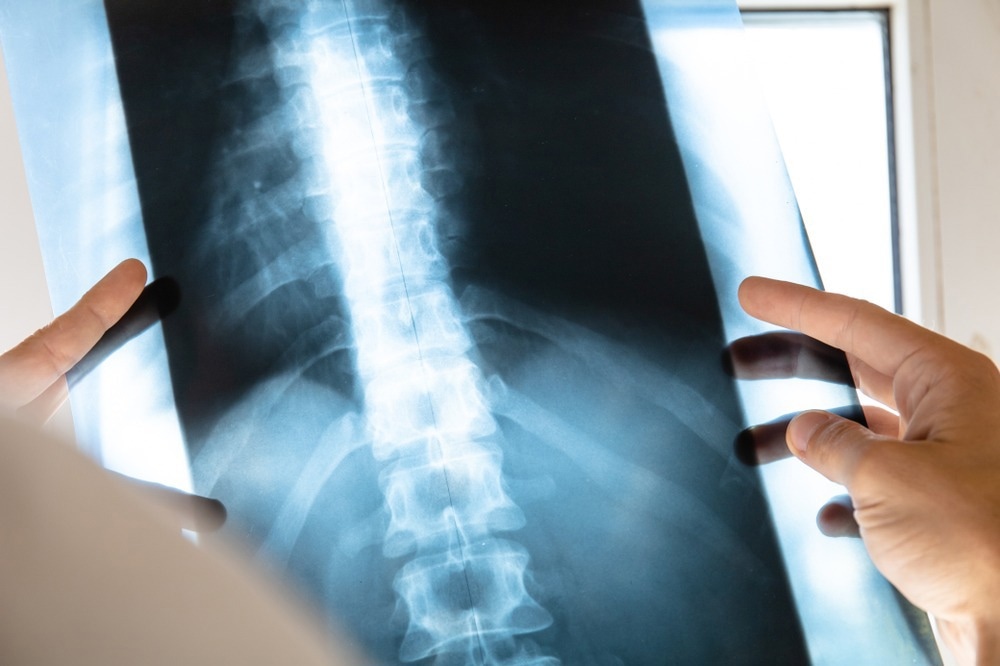Chinese scientists have designed an innovative dopamine-doped chitosan hydrogel for the treatment of spinal cord injuries. Their work has appeared in the journal Carbohydrate Polymers.

Study: Dopamine-modified chitosan hydrogel for spinal cord injury. Image Credit: Sergey Granev/Shutterstock.com
Treating Spinal Cord Injuries
Spinal cord injuries severely affect both the physical and psychological health of patients. Treating these medical problems and providing proper and effective rehabilitation for patients is a complex undertaking due to issues such as inflammation which can affect cell survival.
Spinal cord injuries are highly traumatic events caused by accidents or deliberate violent acts and lead to a loss of sensory, autonomic, and motor functions in affected individuals. These injuries lead to high rates of disability which can severely impact mental health and everyday life, with patients needing round-the-clock care.
These types of injury have a complex pathophysiology and have two stages: primary and secondary injury. The initial injury to the spine is termed the primary injury, and the secondary injury is a physiological reaction to the primary injury. The excessive secondary injury reactions include inflammation, apoptosis (cell death) and electrolyte disturbance which lead to poor local microenvironments.
Currently, the main treatment for spinal cord injuries involves surgical intervention and therapeutic, supportive management, which may not be effective for long-term health outcomes. Some supportive therapies used by clinicians include neuroprotective steroids and decompressive surgery. Additionally, strategies such as invasive brain stimulation and behavioral therapy are used to promote recovery of functions.
A New Approach: Hydrogels
Due to the issues faced by conventional surgical intervention and invasive therapies and the relatively poor health outcomes for patients, research has focused on the search for innovative medical solutions in recent years. The related fields of tissue engineering and regenerative medicine have emerged as forerunners in providing effective medical strategies for these traumatic and life-altering injuries.
In recent years, studies have reported the development of scaffolds constructed from biocompatible biomaterials, which show enormous potential for tissue regeneration. Using these scaffolds for spinal cord injuries can promote neuron migration and axon regeneration, significantly improving the healing rate for patients.
Hydrogels possess many similarities to the body’s extracellular matrix and have been studied intensively in the fields of tissue engineering and regenerative medicine due to their biocompatibility and biodegradability. The three-dimensional network of hydrogels contains high water content.
Chitosan is a polysaccharide contained in biological structures such as the shells of crustaceans that has been widely investigated for constructing hydrogels. It is biocompatible, biodegradable, and non-toxic. Several methods can be used to manufacture hydrogels from chitosan, including ionic and hydrogen bonding, chemical crosslinking, and chelation with metal ions.
There are some key problems with chitosan hydrogels, however. These advanced materials possess insufficient mechanical strength to be properly considered as scaffold structures in biomedical materials. Furthermore, toxic crosslinking agents typically used during their synthesis can cause problems with the safe use of chitosan hydrogels.
Whilst there are still some key challenges to overcome, research has highlighted the inhibitory effect on scar tissue formation when applying chitosan hydrogels to spinal cord injuries. In recent years, studies have indicated that dopamine doping of chitosan hydrogels can enhance cell adhesion and cell affinity, promote neural growth and differentiation, and encourage axon regeneration.
The Study
The authors have presented a novel chitosan hydrogel for treating spinal cord injuries. The hydrogel possesses higher mechanical strength and is modified by dopamine. Citric acid, a non-toxic crosslinking agent, has been used in place of conventional crosslinkers.
Physiochemical properties of the hydrogels include mechanical properties, morphology, and rheological behaviors. To evaluate their suitability as biomedical materials, cell adhesion and cytotoxicity were evaluated using neuron stem cells. Macrophages were used to evaluate cellular immunity.
In addition, the authors conducted a scaffold implantation therapy, which is used for spinal cord injury repair, to evaluate the effectiveness of the hydrogel for this medical purpose. Using rat models, the positive influence of dopamine-doping on promoting immune regulation, nerve regeneration, and motor function recovery was revealed.
The novel hydrogel developed by the authors provides a good microenvironment for the regeneration of spinal cord tissues after injury. However, the paper has noted that the underlying mechanisms which govern the hydrogel’s role in nerve regeneration are unclear. This warrants further exploration in future research.
The study has the potential to function as a knowledge base and critical reference for future studies in tissue engineering and spinal cord injury regenerative medicine. This would significantly improve the medical outcomes for patients who are affected by this traumatic, life-changing, and psychologically damaging type of injury.
Further Reading
Liu, K., et al. (2022) Dopamine-modified chitosan hydrogel for spinal cord injury, Carbohydrate Polymers, p.120047 [online, pre-proof] sciencedirect.com. Available at: https://www.sciencedirect.com/science/article/pii/S0144861722009523?via%3Dihub
Disclaimer: The views expressed here are those of the author expressed in their private capacity and do not necessarily represent the views of AZoM.com Limited T/A AZoNetwork the owner and operator of this website. This disclaimer forms part of the Terms and conditions of use of this website.